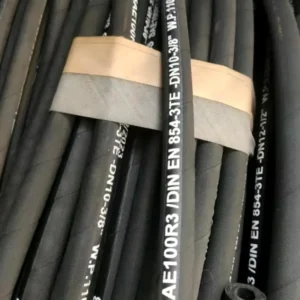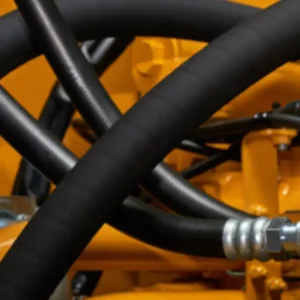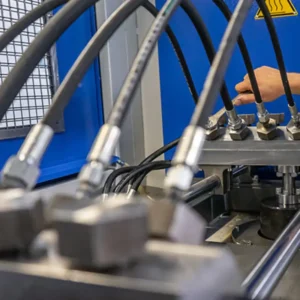Hydraulic system failures can lead to costly downtime, damage, and serious safety risks. A critical factor in preventing these failures is understanding the hydraulic hose burst pressure and its relationship to the system’s operating pressure. We delve into why choosing a hose with the correct rating is not just an industry standard but a safety imperative for system longevity.
Selecting a hose with the appropriate burst pressure ensures that your system maintains integrity, even during unexpected pressure spikes. We guide you through the safety margins and technical specifications to help you make informed decisions. We aim to equip you with the knowledge necessary to secure reliable and high-performance fluid conveyance.
What is Hydraulic Hose Burst Pressure

Hydraulic hose burst pressure is the maximum internal pressure a hydraulic hose can withstand before it ruptures and fails. Unlike working pressure, which is the safe, continuous operating pressure, burst pressure represents the absolute limit of the hose’s structural integrity.
Our hydraulic hose manufacturer determines this value through rigorous laboratory testing, where a hose is pressurized until it bursts. This rating is a crucial safety metric, providing a necessary buffer against unexpected pressure spikes or surges that can occur within a hydraulic system.
Factors Affecting Hydraulic Hose Burst Pressure
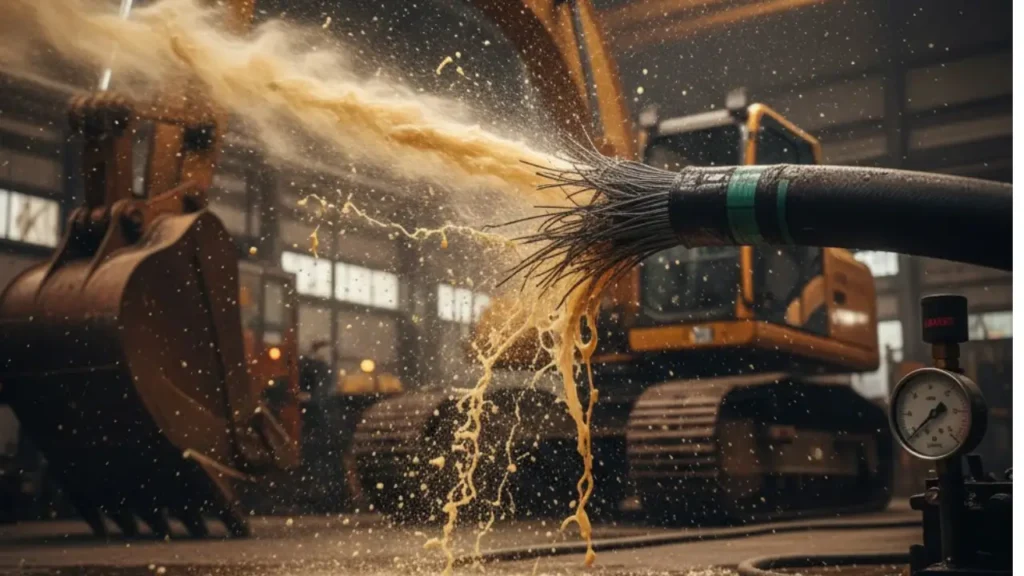
Understanding the factors that influence hydraulic hose burst pressure is crucial for operational safety and system reliability. The structural integrity and longevity of a hose are directly linked to several key variables, encompassing both the hose’s inherent design and the environmental conditions it endures. We consider these elements to ensure superior safety factors.
These factors ultimately determine the maximum pressure a hose can safely withstand before failure. Choosing a hose based on a thorough analysis of these points is vital to prevent unexpected ruptures and maintain peak performance. We only provide hoses engineered to meet stringent industry standards for your applications.
- Hose Construction and Materials We manufacture hoses using specific materials and reinforcement layers that directly impact their strength. Hoses with multiple plies of high-tensile steel wire braiding or spiraling inherently offer higher burst resistance than those with single-ply or textile reinforcement.
- Operating and Fluid Temperature Exposure to temperatures outside a hose’s specified range causes material degradation. High temperatures can soften the inner tube, reducing its strength, while extreme cold can cause brittleness and cracking, both leading to a significant reduction in the rated burst pressure.
- System Pressure Surges Frequent and excessive pressure spikes, also known as water hammer, fatigue the hose’s reinforcement layers over time. This cyclical stress accelerates internal wear and micro-cracking, greatly reducing the actual pressure at which the hose will eventually rupture.
- Hose Aging and External Wear Over time, exposure to environmental elements like UV radiation, ozone, or chemical incompatibility causes the hose material to degrade. External abrasion also damages the cover, exposing and weakening the critical reinforcement wires, leading to premature failure.
Hose Working Pressure vs Burst Pressure

Understanding the difference between hose working pressure and burst pressure is essential for maintaining a safe and efficient hydraulic system. These two distinct pressure ratings govern the operational limits and safety characteristics of any hydraulic hose assembly. We strictly adhere to industry standards to ensure our hoses provide the necessary safety margin for your application’s integrity.
Mistaking one for the other can lead to catastrophic system failure, equipment damage, and serious safety hazards. The working pressure dictates the everyday use of the hose, while the burst pressure provides the critical safety buffer against pressure spikes and unforeseen operational stresses.
Working Pressure (WP)
The working pressure is the maximum pressure a hose can safely and reliably handle under normal, continuous operating conditions. It is the pressure you should use when designing a hydraulic system to ensure long-term performance and durability without causing premature fatigue or wear.
This rating considers factors beyond just strength, including the fluid temperature, environmental conditions, and pressure fluctuations common during operation. We manufacture our hoses with a WP rating that accounts for real-world stress, providing you with a dependable component for your everyday machinery.
Burst Pressure (BP)
The burst pressure is the absolute maximum pressure the hose is designed to withstand before experiencing a catastrophic failure, such as rupturing or bursting. This is a crucial safety rating and is typically determined through rigorous, destructive testing in a controlled laboratory setting.
The burst pressure is intentionally set significantly higher than the working pressure to create a safety factor. We design this reserve capacity to protect the system and personnel from unforeseen pressure spikes that could occur due to malfunctions or valve adjustments.
Safety Factor
The safety factor is the engineered ratio that divides the burst pressure by the working pressure
For most hydraulic hoses, the industry standard safety factor is 4:1, meaning the burst pressure must be at least four times the working pressure.
We commit to this 4:1 safety factor to build in a significant margin of protection. This buffer accounts for potential material variances, wear over time, and sudden, high-intensity pressure impulses within the system.
Purpose and Function
The primary purpose of the working pressure is to guide the proper selection and operation of the hose for its intended application. It is the sustained pressure limit that the hose is expected to handle throughout its service life without fatigue.
Conversely, the primary function of the burst pressure is to define the ultimate structural limit and provide a critical safety net. It is a threshold that the system should never approach, ensuring that accidental over-pressurization does not immediately lead to failure.
Testing and Certification
The working pressure is a calculated, rated value that dictates the hose’s intended operating performance. It’s the pressure point that all system design parameters must respect to ensure reliable daily use.
The burst pressure, however, is verified through physical, destructive testing where a hose sample is pressurized until it fails. This test confirms that the hose construction meets the minimum required safety factor against rupture.
| Aspect | Working Pressure (WP) | Burst Pressure (BP) |
| Definition | Maximum safe continuous operating pressure. | Minimum pressure at which a hose is expected to rupture. |
| Ratio | The lower, operational pressure limit. | Typically 4x (or more) the Working Pressure. |
| Purpose | Guides system design and operational limits. | Provides the critical safety margin against failure. |
| Application | Normal, everyday fluid transfer operation. | An absolute limit; should never be reached in use. |
| Testing | Calculated rating based on materials and design. | Verified by destructive physical testing to failure. |
What is the Standard for Burst Pressure?

The primary standard governing hydraulic hose burst pressure is the requirement for a Safety Factor against the hose’s maximum rated working pressure. This standard is rigorously enforced by international organizations like the Society of Automotive Engineers (SAE) and the International Organization for Standardization (ISO).
Specifically, most industry standards, such as those in the SAE J517 100R Series, mandate that the minimum burst pressure must be at least four times (4:1 ratio) the stated working pressure. We design our hoses to meet and often exceed this critical benchmark to ensure operational safety and system resilience against unexpected pressure spikes.
This 4:1 safety factor is crucial and is verified through the SAE J343 testing standard, which details the procedures for hydrostatic burst testing. During this destructive test, a hose sample is subjected to increasing internal pressure until it ruptures.
The pressure recorded at the moment of failure must be equal to or higher than the minimum burst pressure defined by the hose’s working pressure rating.
Other key standards, like ISO 18752, classify hoses by constant working pressure across all diameters and performance grades, further streamlining the selection process while still adhering to the fundamental burst pressure safety requirements.
Why Do Your Hydraulic Hoses Burst?
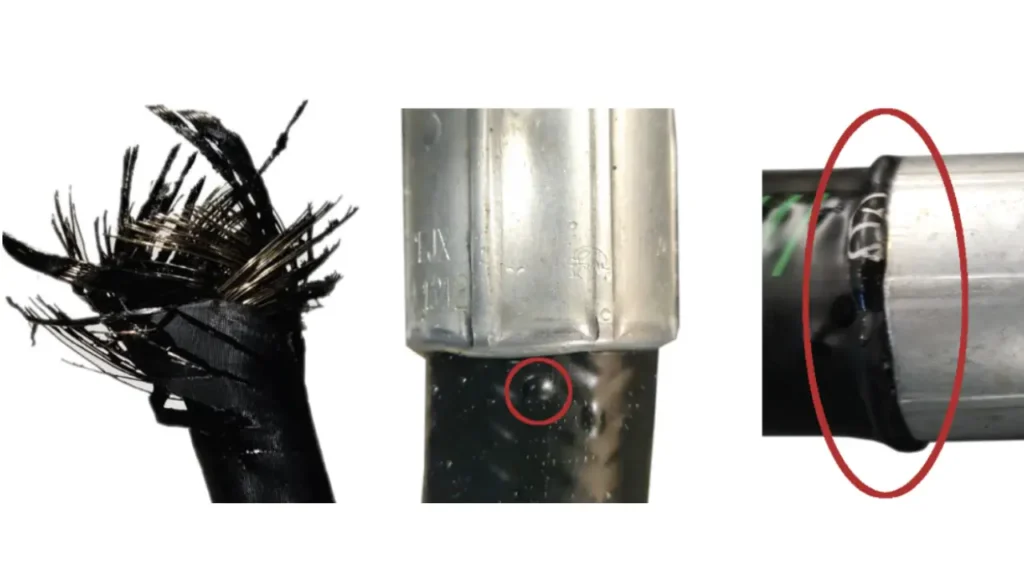
Understanding why hydraulic hoses burst is critical for preventive maintenance and safety in any operation. Most failures are not sudden surprises but the result of cumulative stresses that exceed the hose’s designed limits. We analyze these common causes to help you maintain system integrity and prevent costly downtime.
Hose bursts typically occur when the hose’s actual strength falls below the pressure required by the system, often due to degradation or improper assembly. Identifying these factors allows you to implement better practices and ensure your equipment remains reliable and operational.
- Exceeding the Working Pressure (Over-Pressurization): System pressure spikes, especially those that frequently exceed the hose’s maximum rated working pressure, are a leading cause of failure. This constant overstressing fatigues the reinforcement layers, quickly weakening the hose and ultimately reducing the necessary safety factor against rupture.
- Improper Installation and Bending Radius: Routing a hose in a radius tighter than the manufacturer’s specification puts extreme stress on the outer layers. This tight bending causes internal friction and premature abrasion on the reinforcement wires, leading to localized weak spots where the hose is likely to burst under normal working pressure.
- External Damage and Abrasion: Physical damage, such as continuous rubbing against sharp components, severely wears down the hose’s protective outer cover. Once the reinforcement wires are exposed, they are vulnerable to corrosion and fatigue, drastically reducing the hose’s capacity to contain high-pressure fluids.
- Fluid and Temperature Incompatibility: Using hydraulic fluid that chemically degrades the hose’s inner tube or operating the hose outside its specified temperature range accelerates material breakdown. This deterioration weakens the hose structure from the inside, making it prone to bursting even at lower than rated pressures.
How to Avoid Hydraulic Hose Bursts?

Preventing a hydraulic hose burst is achievable through rigorous attention to component selection, proper installation, and scheduled maintenance. A proactive approach significantly extends the life of your assemblies and, most importantly, protects personnel from the severe hazards of sudden high-pressure failure. We offer guidance to help you implement best practices.
Minimizing operational risk involves moving beyond a simple “fix-it-when-it-breaks” mentality. By following clear maintenance protocols, carefully checking for early warning signs, and investing in correctly rated components, you can ensure a reliable and safe hydraulic system.
- Verify Proper Hose Selection: Always select a hose where the working pressure rating is appropriate for your system’s maximum pressure, including potential spikes. We provide hoses engineered with the standard 4:1 safety factor, ensuring the burst pressure offers the necessary safety buffer for reliable operation.
- Adhere to Minimum Bend Radius: Never route a hydraulic hose tighter than the manufacturer’s specified minimum bend radius. Excessive bending causes internal stress and fatigue in the wire reinforcement, critically reducing the hose’s ability to withstand its rated working pressure over time.
- Protect Against Abrasion and Rubbing: Abrasion is a leading cause of premature failure. Ensure hoses do not rub against each other, sharp edges, or moving parts. We recommend using protective sleeves, spiral wraps, or clamps to shield the outer cover and maintain the integrity of the crucial internal reinforcement.
- Monitor and Control System Temperature: Operating temperatures above the hose’s maximum limit degrade the inner tube material, weakening the assembly. Route hoses away from heat sources like exhaust manifolds, and ensure your system’s cooling is efficient to prevent thermal deterioration and maintain the hose’s specified limits.
- Regularly Inspect and Proactively Replace: Implement a routine inspection schedule to check for cuts, bulges, leaks, and stiffening. Hoses have a finite life; we advise tracking service hours and replacing hoses before they reach the end of their recommended service life, even if they appear undamaged.
Conclusion
Ensuring system integrity hinges on a thorough understanding of hydraulic hose burst pressure and the necessary safety margin. By committing to hoses with the correct pressure ratings, you are actively minimizing the risk of catastrophic failure and maximizing the lifespan of your heavy equipment. This proactive approach guarantees safer and more reliable operations across your entire application range.
Choosing a hose that meets or exceeds the technical demands of your system is paramount for operational excellence. The minimal investment in a superior, correctly rated hose far outweighs the potential financial and safety costs associated with burst-related downtime or equipment damage. We prioritize your success by supplying components engineered for peak endurance.
For dependable, top-tier hydraulic hose solutions that fully comply with industry-leading safety standards, look no further. We supply and manufacture wholesale hydraulic hoses designed for resilience and performance. To optimize your system with reliable pressure ratings, be sure to get wholesale hydraulic hoses from our Gushan Rubber.

